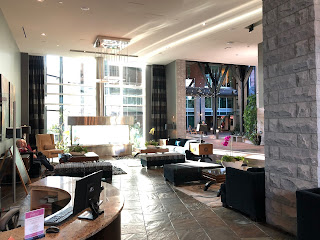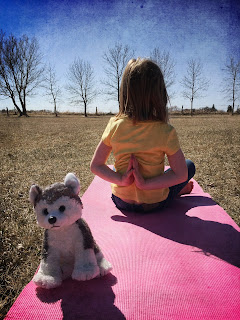Hide and Seek Coffee, 2207 Oak Bay Avenue, Victoria
 |
| Oak Bay is such a charming neighbourhood! |
Located in a brick building with high ceilings and large windows, Hide and Seek Coffee packs a big aesthetic appeal. The decor is minimalist with lots of white and light wood, accented with artistically arranged shelving with coffee and various merchandise for sale. The coffee bar is long and white and everything looks sparkling clean. Music selections were great--singer-songwriter, folk-inspired, and some 1960s Beatles-sounding tunes added to the ambiance. And when you throw in that this coffee house is located in the incredibly charming Oak Bay neighbourhood, you have a winner for sure.
 |
| Beautifully arranged merchandise |
 |
| Barista Kelsey behind the long coffee bar |
There are a variety of tables and seating options available, with power outlets located under some of the tables. Natural light floods the space, and wifi is available. This intimate yet uncrowded coffee house is definitely a pleasant space to work!
 |
| Lots of natural light here |
Coffee and Food
I wasn't hungry, but I did notice that they have homemade pop-tarts and vegan/gluten-free selections. My latte was excellent, made with non-fat milk and house-made vanilla syrup, which was their only flavour. It was served in a nice cup with terrific latte art. Worthy of noting: although they don't roast their own beans, they serve coffee from local roasters such as Fantastico and Fernwood.Overall Impression
I'll definitely return here--it's near my apartment and meets all my requirements for a great work space. The barista who served me (Kelsey) was super friendly and took time to explain where they source their coffee, provided recommendations for other coffee houses to visit, and encouraged me to return on Sunday for their famous waffle features. The only negatives were the lack of latte flavours and limited outdoor seating (only a bench and a couple of stools, no tables).
Habit Coffee (The Atrium), 808 Yates Street, Victoria
Appearance and Atmosphere
Habit Coffee is big on visual impact, and I was impressed from the moment I spied their Yates Street location. Massive curving windows flood the space with natural light and provide a panoramic view of the bustling action on busy Yates Street. There's also a sunny patio with flowers and numerous tables, as well as a fantastic courtyard space available for customers' use. Wow!
The decor includes natural wood, rugged stainless steel, exposed concrete, and chalkboard menus, giving a chic industrial look. Music selections added to the ambiance. Habit Coffee rates high on appearance and atmosphere!
 |
| Open, airy, and lots of natural light |
 |
| This adjacent courtyard is beautiful! Wow! |
Work Space
The abundance of natural light and different seating options lend themselves nicely to a productive work space. This is a great place to pass the time with a book or a sip a coffee and watch the world go by. Unfortunately it is not well-suited to anyone who requires wifi or power outlets, as there is a dearth of both. I'm drafting this post tethered to my iPhone. Definitely a disappointment....but now that I know this, I would choose Habit for tasks not requiring wifi (or get access from one of the other businesses nearby). And sometimes not having internet access keeps me more focused on the task at hand!
 |
| Great views and many seating options, but NO WIFI! |
Similar to Hide and Seek, the only flavoured latte available was a vanilla latte. My latte was beautifully crafted with terrific latte art, and served in a clear glass with no handle, evoking memories of Europe. It was a delicious latte and reasonably priced at $4.50. Habit Coffee brews Bow and Arrow products from a local roaster and stocks Phillips' sodas as well. There was a tempting selection of food, and the lemon-lavender muffin definitely caught my eye--something to look forward to on a future visit.
Overall Impression
This place is big and beautiful with huge aesthetic appeal, and the sunny patio is a nice bonus. I would definitely return, but having to pay for street parking and no wifi or power outlets are disadvantages that would impact my decision to work here. All in all, Habit Coffee is highlight of the Victoria coffee scene!
Tre Fantastico at Parkside Hotel and Spa, 810 Humboldt Street, Victoria
Appearance and Atmosphere
Located in Parkside Hotel and Spa, Tre Fantastico is a coffee house on steroids...a cafe as well as a lounge with great eats. The actual interior space is quite small--the main room contains the coffee bar where you order and a handful of tables, connected to a second room by a hallway. There are more seating options in here with some cool modern art on the walls. All of this is quite nice, but the decor isn't the reason I'm obsessed with this place--it's the fantastic outdoor patio and the hotel lobby and conservatory area that patrons can access. The patio is shaded with beautiful greenery, and I love looking up from my screen or book to rest my eyes on the historic St. Ann's Convent in the distance.
 |
| A great spot to take a break from studying |
The hotel lobby is incredibly inviting, with a variety of seating options, including a glassed-in conservatory space. When I'm craving warmth and natural light on cooler days, it is so pleasant to work in here under the mini lights by the fish pond. Lastly, there are really nice bathrooms to use with high-end hand soap and lotion. What I did learn was that you CAN'T take your wine into the lobby area, but non-alcoholic drinks are allowed!
 |
| A nice variety of seating options in the hotel lobby |
 |
| A fish pond...such a tranquil spot to read |
Tre Fantastico (the cafe space) is a lovely spot to read or work on a laptop. The wifi is strong, and you can work on your laptop outside if you choose a shaded spot. The only disadvantage is a lack of power outlets--I only found one on a quick inspection, so make sure your devices are fully charged before you arrive. The hotel lobby and conservatory is better suited to reading, as there are no tables (other than coffee tables) to put your device on, and they are the wrong height for computer work. I have happily worked here for hours, and I always found it a functional space and enjoyable experience.
Coffee and Food
There are three Cafe Fantastico locations in the city, and Fantastico has been sourcing and roasting their own coffee beans for 25 years (according to the friendly barista). The caramel lattes are excellent here with lovely latte art, and so is the food. I love their Morning Glory muffins, and the cookies and scones look great too. For heartier fare, I've only ever had the breakfast sandwich (which was delicious) but the food I've seen around me has looked very tempting too.
 |
| Caramel latte and a Morning Glory muffin...mmmm! |
Overall Impression
Tre Fantastico packs a big punch with the combination of great food and drinks and gorgeous physical spaces. This is one of my favourite places to work and study in Victoria, made even nicer by the fact that I can stroll through St. Ann's to Beacon Hill Park for a break whenever I need one!
And there you have it...my first three reviews of some of Victoria's best coffee houses. Stay tuned for another post in this series, and I'd love your feedback on where I should visit next. Please share your ideas in the comments. Thanks for reading!















